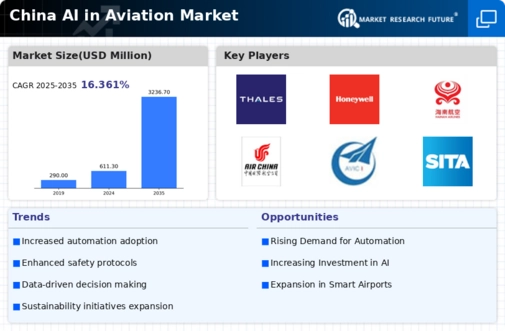Focus on Safety and Security
Safety and security remain paramount in the aviation industry, and the integration of AI technologies is becoming increasingly vital in addressing these concerns. In China, the ai in-aviation market is witnessing a heightened focus on utilizing AI for enhancing safety protocols and security measures. AI-driven systems are being deployed for real-time monitoring of aircraft systems, predictive maintenance, and threat detection at airports. This emphasis on safety is supported by government initiatives aimed at improving aviation security standards. As a result, the ai in-aviation market is expected to see substantial growth, with investments in AI safety solutions projected to reach $5 billion by 2026. The commitment to safety and security not only enhances passenger confidence but also positions the ai in-aviation market as a leader in innovative aviation solutions.
Rising Demand for Air Travel
The increasing demand for air travel in China is a pivotal driver for the ai in-aviation market. As the middle class expands, more individuals are opting for air travel, leading to a surge in passenger numbers. This trend necessitates the adoption of AI technologies to manage the growing complexities of air traffic and enhance customer experiences. The ai in-aviation market is responding to this demand by developing AI solutions that streamline operations, such as automated check-in processes and personalized travel recommendations. According to recent forecasts, the number of air passengers in China is expected to exceed 1 billion by 2030, which will likely propel the ai in-aviation market to new heights. This burgeoning demand underscores the importance of integrating AI to maintain efficiency and meet passenger expectations.
Technological Advancements in AI
Technological advancements in AI are significantly influencing the ai in-aviation market in China. Innovations in machine learning, data analytics, and automation are enabling the development of sophisticated AI applications tailored for aviation. These technologies are being utilized for various purposes, including predictive analytics for maintenance, optimizing flight routes, and enhancing passenger services. The rapid pace of technological evolution suggests that the ai in-aviation market will continue to expand, with new applications emerging regularly. Market Research Future estimate that the market could grow by 15% annually as companies leverage these advancements to improve operational efficiency and customer satisfaction. The continuous evolution of AI technologies is likely to create a competitive landscape, driving further investment and innovation in the sector.
Investment in Smart Infrastructure
China's commitment to developing smart infrastructure is a significant driver for the ai in-aviation market. The government is investing heavily in modernizing airports and air traffic control systems, integrating AI technologies to enhance operational capabilities. This investment is not only aimed at improving efficiency but also at ensuring safety and security in air travel. For example, the implementation of AI-based systems for real-time data analysis and decision-making is becoming commonplace. The ai in-aviation market is projected to benefit from these advancements, with an estimated market value reaching $10 billion by 2027. The focus on smart infrastructure is likely to create a conducive environment for AI innovations, thereby attracting investments and fostering competition among industry players.
Regulatory Support for AI Integration
The regulatory landscape in China is increasingly supportive of AI technologies, particularly in the aviation sector. The government has established frameworks that encourage the adoption of AI in various applications, including air traffic management and safety protocols. This regulatory backing is crucial for the ai in-aviation market, as it fosters innovation and investment. For instance, the Civil Aviation Administration of China (CAAC) has initiated guidelines that promote the use of AI for enhancing operational safety and efficiency. As a result, The AI in Aviation market is projected to witness a surge in AI-driven solutions, with projections indicating a growth rate of approximately 20% annually over the next five years. This supportive environment is likely to attract both domestic and international players, further stimulating market expansion.

















Leave a Comment